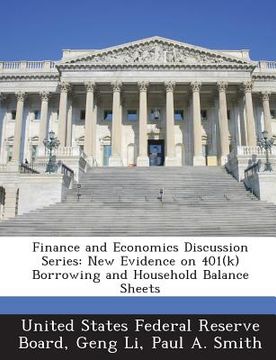Compartir
Finance and Economics Discussion Series: New Evidence on 401(k) Borrowing and Household Balance Sheets (en Inglés)
United States Federal Reserve Board
(Autor)
·
Paul a. Smith
(Autor)
·
Geng Li
(Autor)
·
Bibliogov
· Tapa Blanda
Finance and Economics Discussion Series: New Evidence on 401(k) Borrowing and Household Balance Sheets (en Inglés) - Li, Geng ; Smith, Paul a. ; United States Federal Reserve Board
25,16 €
26,48 €
Ahorras: 1,32 €
Elige la lista en la que quieres agregar tu producto o crea una nueva lista
✓ Producto agregado correctamente a la lista de deseos.
Ir a Mis Listas
Origen: Estados Unidos
(Costos de importación incluídos en el precio)
Se enviará desde nuestra bodega entre el
Martes 16 de Julio y el
Martes 30 de Julio.
Lo recibirás en cualquier lugar de España entre 1 y 5 días hábiles luego del envío.
Reseña del libro "Finance and Economics Discussion Series: New Evidence on 401(k) Borrowing and Household Balance Sheets (en Inglés)"
Despite news reports suggesting a rise in 401(k) borrowing in recent years, we find that the share of eligible households with 401(k) loans in the 2007 Survey of Consumer Finances was about 15 percent, roughly what it has been since 1995. We find that the best predictors of 401(k) borrowing appear to be the presence of liquidity or borrowing constraints and the size of 401(k) balances relative to income. Since the ongoing financial crisis has likely caused these factors to move in opposite directions, the predicted effect of the crisis on 401(k) borrowing is ambiguous. More fundamentally, we find that many loan-eligible households carry relatively expensive consumer debt that could be more economically financed via 401(k) borrowing. In the aggregate, we estimate that such households could have saved as much as $5 billion in 2007 by shifting expensive consumer debt to 401(k) loans. This would translate into annual savings of about $275 per household-roughly 20 percent of their overall interest costs--with larger reductions for households that carry consumer debt at high interest rates or who hold larger 401(k) balances. We posit that households might utilize 401(k) loans less than expected due to risk-aversion, self-control problems, and confusion about the potential gains, and suggest better financial education that clarifies the conditions under which 401(k) borrowing is advantageous. Finally, we note that allowing households to repay 401(k) loans gradually even after separation from their employers could improve household welfare by reducing the risks of 401(k) borrowing.
- 0% (0)
- 0% (0)
- 0% (0)
- 0% (0)
- 0% (0)
Todos los libros de nuestro catálogo son Originales.
El libro está escrito en Inglés.
La encuadernación de esta edición es Tapa Blanda.
✓ Producto agregado correctamente al carro, Ir a Pagar.

